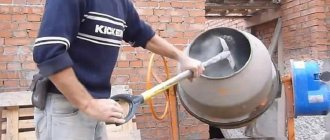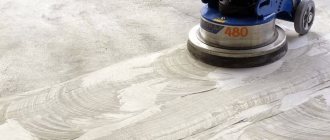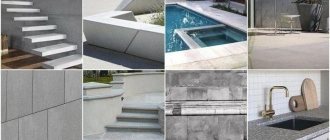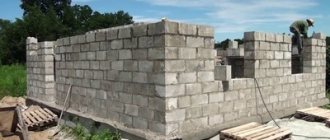Composite or geopolymer concrete has become relevant recently, as the environmental situation in the world is deteriorating and manufacturers are trying to produce products that do not have a harmful impact on the environment. This type of material, such as geopolymer, is considered environmentally friendly, consisting of natural materials. Compared to the standard type, it has a quick hardening time (up to 1 week) and is more resistant to acids and other chemical elements.
What is geopolymer material?
The appearance of the recipe is associated with the polymerization of components of geological origin during the reaction of the material and the alkaline environment. When properly combined and proportioned, they form a monolith. This process is carried out at low temperatures, due to which chemical bonds occur. Slag imparts strength, and ash increases the compressive strength.
Geopolymer recipe
The innovative material in its composition, instead of sand, gravel and crushed stone, also includes such components as:
- Fly ash is dispersed particles.
- Slag is a by-product from metal production.
- Astringents that help bind pigment particles together. The substances are represented by liquid glass and potassium hydroxide.
- Inert filler. Occupies most of the base of polymer concrete.
- Mineral chips, quartz sand, wood shavings, perlite.
The amount and type of filler affect the load-bearing and insulating qualities, therefore, for heavy types of structures, grains up to 4 mm are used.
Properties of cement
The advantage of geopolymer concrete is its fire resistance and resistance to high temperatures.
Particular attention of researchers in the field of construction was paid to studying the characteristics of geopolymer concrete. During testing, it was found that the geopolymer is resistant to corrosion. The carbon dioxide emitted during production, compared to other types, is 90% less, which reduces the greenhouse effect. According to the results of tests in the laboratory for fire resistance, the material can withstand up to 1316 °C. During the experiment, a geoconcrete sample was exposed to a high temperature of 230 °C for 2 days. After assessing the condition, it was concluded that the source not only did not ignite, but also did not crack or chip along its entire surface.
Fly ash in concrete provides material properties in which it is not inferior to Portland cement, and even superior to it. It is characterized by rapid hardening and multiple freeze-thaw cycles. Among its main advantages are the following:
- high strength (like natural deep rock stone - granite);
- absence of longitudinal and axial deformation;
- low, close to zero, permeability;
- high elasticity.
Manufacturing
All bulk substances that make up the geopolymer must be mixed in a separate container made of reinforced glass, then carefully pour water cooled to room temperature into them. To avoid uneven hardening, the solution is stirred with a wooden spatula until it becomes completely homogeneous.
A sign of a reaction occurring will be heating of the mixture, accompanied by the release of carbon dioxide bubbles. If you subject the composition to additional heat treatment, heating it to 80 degrees, it will harden within a day. Hardening under standard conditions will extend this period by a week, but the chemical processes taking place inside the concrete will make it a durable monolithic structure, well suited for construction.
Geopolymer technology for concrete production
The raw materials for the production of building materials are ash and slag, of which there are many reserves on the planet.
In the room where mixing is carried out, it is imperative to monitor the humidity, it should be low. The process of mixing the components is carried out quickly so that the mixture does not thicken. Humanity has an inexhaustible supply of raw materials for the production of concrete, such as ash and slag, so the production of geoconcrete is gaining momentum. The production of geopolymer concrete is carried out according to the following regulatory document: TU 5870-006-30993911-2014 “Geopolymer. Technical conditions".
View "TU 5870-006-30993911-2014" or
New is well forgotten old
The emergence of environmentally friendly building materials is due to pollution and the unpleasant appearance of dilapidated old buildings.
The government reluctant to demolish old buildings and structures - the entire dismantling takes a lot of time and money.
The work is carried out in several stages , which include demolition, removal, processing and disposal of waste. With older geopolymer concrete buildings, such problems can be avoided.
Building materials created on a natural basis do not require expensive disposal, which saves a lot of time and money.
Areas of use
Previously, geoconcrete was used to lay paths, but with the study of the material, the possibilities have expanded. For example, in Austria they created an airport with technical buildings made of such material. Geopolymer concrete is used for complex structures: heavy-duty beams and panels, railway sleepers and sewer pipes. In addition, bridges and various volumetric structures are erected from it due to its elasticity and stability. And in architecture it is suitable for making columns, creating sculptures or monuments. Geoconcrete can be used in almost all elements and products in which the classic type is used.
Who built the pyramids?
The construction of a pyramid as imagined by an artist
It is logical to assume that all workers needed somewhere to sleep and something to eat. All this was available in special villages for builders. The remains of one of them were found near three pyramids in Giza, an Egyptian city on the west bank of the Nile River. Excavations in this area have been ongoing since the 1960s. During all this time, archaeologists managed to find the burial places of architects, foremen and ordinary workers. Their tombs were very different - the architects who contributed greatly to the design of the pyramids were buried inside the tombs. Ordinary workers, in turn, were buried in ordinary graves.
On the territory of the construction villages there were workshops where tools were made. There were also places for preparing food for workers: bakeries, breweries and storerooms for drying fish. In addition to all this, archaeologists have found places to offer sacrifices to the deceased pharaohs. Apparently, Ancient Egypt was a rich place because the inhabitants could afford to sacrifice even young animals.
Beer is considered the main alcoholic drink of Ancient Egypt
How to make geoconcrete with your own hands?
Geopolymer concrete is under development, the composition and calculation of the amount of ingredients for its production is difficult to find in the documentation, so enterprises rely on specifications. The recipe for preparing 1 kg of monolithic building material with your own hands is as follows (components are indicated in grams):
- ash - 330;
- liquid crystal glass - 200;
- 40% potassium hydroxide obtained by electrolysis—90;
- slag residue after metal combustion - 330;
- cold water - 55.
The composition of geopolymer concrete for the necessary elasticity includes special polymer additives: PVA glue, epoxy or polyamide resin.
Preparing for work
Before starting work, you must wear protective equipment to avoid burns.
To begin with, you should pay attention to protective equipment, since the ingredients for mixing are aggressive and can cause burns to the mucous membranes. The following inventory is prepared:
- latex gloves;
- eye protection;
- workwear;
- respirator.
When mixed, chemical elements emit a large amount of heat, so when working with them, use a basin or other container that is resistant to high temperatures. To quickly harden the dough, electrolytes are applied to the formwork. To make geopolymer concrete yourself at home, you will need the following tools and materials:
- tub;
- wooden spatula when working with alkali;
- portable scales;
- electrolytes;
- form.
Mixing the solution
Dry ingredients and water are placed in a concrete mixer. Add ash and slag in a ratio of 50:50. The next step is to add polymers and mix the mixture thoroughly. Polymer components can be PVA glue, resin with water-soluble properties. The constituent elements of the glue replace the binder. And wood, crushed into chips and added to the mixture, allows you to achieve a uniform desired color after hardening. It is soaked in water and treated with ozone, then included in the solution. To reduce the high hardening rate during mixing, boric acid salt (Na2B4O7) is used.
Pouring the mixture into molds
The finished mixture is poured into molds, while monitoring and eliminating voids if any appear.
The formwork is lubricated with oil and reinforcement is installed if necessary. Next, the form is filled with the prepared solution. Using an inverter, the mass is exposed to current for one hour; after preliminary hardening, the formwork is removed. Concrete gains strength depending on temperature conditions, and this process is accelerated when heated by electrodes. During pouring, the presence of voids is monitored and eliminated, due to which the geopolymer structure may subsequently crack. Hardening and formation of a surface film occurs within 24 hours. The film increases solidity and the ability to withstand heavy operating loads.
Pyramid of Ancient Egypt in section
If we examine the internal contents of the pyramid in cross-section, then it is easy to determine the place for installing a sarcophagus - a burial chamber, somewhere in the center of the pyramid, with the installation of five to seven ventilation ducts and hatches of different sections with an inclination of 45 degrees.
From above, the sarcophagus is protected by a tent-type canopy made of multi-ton marble slabs, which strengthens the fastening and protection of the sarcophagus from the weight of the ceiling, the subsidence of the masonry blocks of the pyramids of ancient Egypt from above, which in early projects led to its destruction.
Work on the construction of the burial chamber, underground passages, grottoes, false passages, lighting and ventilation shafts, tunnels, dead ends, anti-vandal bolts, corner fastenings, wastewater discharge systems and storm water drainage systems were carried out before the construction of the pyramid, the so-called zero construction cycle.
The question: “How was a multi-ton sarcophagus carried through such narrow tunnels?” is fundamentally incorrect. It was installed in place even before the construction of the pyramid began in Ancient Egypt, on a pre-built mastaba or below it at a depth of 20-60 meters!
The embalmed body of the pharaoh was carried into the sarcophagus along the corridors after the construction of the main building was completed. With him they brought food and clothing that could be useful to him in the other world. Upon completion of the loading of the burial chamber and sarcophagus, the entrance and ventilation tunnels were covered with multi-ton granite slabs. Small openings were left in them for the passage of air and communication between the pharaoh and the world. Neither marble valves nor deep shafts saved the tomb from robbery.
Everything that was built above the mastaba level, such as ventilation shafts, was done while laying stone blocks. Compared to processing tunnels and passages with a simple copper chisel with a low surface quality, the walls of the burial room were made with special care - polished and painted with hieroglyphs.
Construction of the pyramids of Ancient Egypt
Advantages and disadvantages
Geopolymer concrete is easy to manufacture. An important quality of geoconcrete is the creation of a smooth surface that gains strength over time. The necessary ingredients for preparing the solution are easy to find and inexpensive. When using an innovative solution, construction costs are reduced and structures are built with fewer initial building materials. The low thermal conductivity of geopolymer material reduces the cost of heating industrial premises.
Among the advantages of geopolymer concrete are the following:
- low shrinkage;
- high compressive strength of concrete;
- fire safety;
- low air and vapor permeability;
- environmental friendliness and safety;
- production with added waste;
- rapid hardening;
- compliance to mechanical influences, for example, diamond wheels;
- low cost;
- the ability to make a mixture by distributing the components in a recipe.
The advantage of geoconcrete is its resistance to corrosion and rapid hardening of the solution. 2 days after filling the form, processing can be done, and the process of complete hardening occurs in 7 days, while the classic type of concrete has a hardening period of 28 days. Geopolymer concrete is environmentally friendly with a high degree of adhesion to materials, withstands temperature fluctuations, and is not prone to deformation processes and cracking. But it has one drawback - imperfect production technology (at the development stage). Mass production is therefore difficult.
Advantages
Geopolymer composite has many advantages over traditional materials due to its unique formulation. The material has the following positive characteristics:
- Maintaining the dimensions of products in contact with the mortar during construction work.
- Insignificant shrinkage, ensuring a reduction in the construction cycle due to finishing immediately after the construction of the walls.
- Increased resistance to compressive forces, which allows the construction of objects with an increased number of storeys.
- Resistant to temperature fluctuations while maintaining integrity during deep freezing and repeated thawing.
- Reduced concentration of greenhouse gases released. If we compare the structure of the new building material, it resembles that of natural stone, due to which it has higher properties than conventional mortar
- Resistant to contact with aggressive liquids and chemicals.
- Fire safety, allowing polymer concrete to maintain its integrity and structure at temperatures above 900 degrees.
- Reduced vapor permeability coefficient, which is similar to natural stone.
- Possibility of cutting and processing using hand-held mechanized tools equipped with a diamond working body.
- Highly environmentally friendly, safe for others, due to the absence of toxic substances in the composition.
- Use of industrial waste in the production process, which has a positive effect on the environmental situation of the region.
- Accelerated hardening of the composition, the drying time of which is 2 times less than that of traditional concrete.
- At an affordable price, allowing customers with average incomes to purchase the material and carry out construction using geopolymer concrete.
- The ability to make geopolymer concrete with your own hands using available ingredients.
- Resistant to corrosion processes that gradually destroy ordinary reinforced concrete. If you have all the necessary components and tools, you can prepare geopolymer concrete yourself
- Improved heat-saving properties to ensure a comfortable room temperature.
- Low density, making it easier to transport the material and perform masonry-related work.
A set of positive characteristics significantly distinguishes polyconcrete from standard concrete mortar.
Properties
Historical reference
As we have already said, this material is innovative. However, there is evidence that it was used several thousand years ago in the construction of the Egyptian pyramids. Of course, we are only talking about similar technology.
The blocks from which the pyramids were built consisted of the following components: silt from the Nile River, limestone, gravel, salt, ash and crushed lime. As a result, they were able to stand for so long without becoming covered in cracks. At the same time, the so-called “tan” did not form on them (any natural stone becomes covered with it over time).
Advantages
Now it's time to get acquainted with the advantages of this know-how:
- . Even cutting reinforced concrete with diamond wheels will hardly cope with its task.
- Long lifespan
. Significantly higher than that of its ancestor. - Very low drying shrinkage
. - High compressive strength
. This allows you to withstand enormous loads. - Resistant to almost any acid
. - The technology of polymer concrete is significantly different from all known ones
. The fact is that only environmentally friendly raw materials are used in its production.
- Polymer concrete products have low greenhouse gas emissions.
- Calmly withstands temperature changes
. It retains all its properties even when heated to 1300 degrees. - Does not wear out over time and does not crumble
.
Among all this variety of advantages, there is one drawback - the high price. However, the situation will certainly change in the future. The fact is that this is a new technology, which means that for some time its cost will be significantly reduced.
Specifications
The wild growth in popularity is due to the fact that polymer-cement concrete has very high characteristics that leave all its main competitors out of the running. Let's get acquainted with them:
| Characteristic name | Meaning |
| Frost resistance (number of cycles) | 300 |
| Water absorption coefficient per day (%) | No more than 0.1 |
| Abrasion (g/cm2) | 0,02 |
| Strength (kgf/cm2) In compression In tension | 900–100075–85 |
| Porosity (%) | 1–1,5 |
| Linear shrinkage (%) | 0,3–1 |
| Creep measure (sq.cm/kg) | 0,4–0,5 |
| Aging resistance (points) | 3–4 |
It is also worth bringing to your attention chemical resistance to various substances:
From the data in this table it is clear that this material meets all standards of chemical resistance. This means that polymer protection of concrete floors is highly effective. Therefore, this technology is quite often used in industry.











